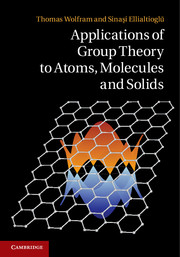Book contents
- Frontmatter
- Contents
- Preface
- 1 Introductory example: Squarene
- 2 Molecular vibrations of isotopically substituted AB2 molecules
- 3 Spherical symmetry and the full rotation group
- 4 Crystal-field theory
- 5 Electron spin and angular momentum
- 6 Molecular electronic structure: The LCAO model
- 7 Electronic states of diatomic molecules
- 8 Transition-metal complexes
- 9 Space groups and crystalline solids
- 10 Application of space-group theory: Energy bands for the perovskite structure
- 11 Applications of space-group theory: Lattice vibration
- 12 Time reversal and magnetic groups
- 13 Graphene
- 14 Carbon nanotubes
- Appendix A Vectors and matrices
- Appendix B Basics of point-group theory
- Appendix C Character tables for point groups
- Appendix D Tensors, vectors, and equivalent electrons
- Appendix E The octahedral group, O and Oh
- Appendix F The tetrahedral group, Td
- Appendix G Identifying point groups
- Index
- References
5 - Electron spin and angular momentum
Published online by Cambridge University Press: 18 December 2013
- Frontmatter
- Contents
- Preface
- 1 Introductory example: Squarene
- 2 Molecular vibrations of isotopically substituted AB2 molecules
- 3 Spherical symmetry and the full rotation group
- 4 Crystal-field theory
- 5 Electron spin and angular momentum
- 6 Molecular electronic structure: The LCAO model
- 7 Electronic states of diatomic molecules
- 8 Transition-metal complexes
- 9 Space groups and crystalline solids
- 10 Application of space-group theory: Energy bands for the perovskite structure
- 11 Applications of space-group theory: Lattice vibration
- 12 Time reversal and magnetic groups
- 13 Graphene
- 14 Carbon nanotubes
- Appendix A Vectors and matrices
- Appendix B Basics of point-group theory
- Appendix C Character tables for point groups
- Appendix D Tensors, vectors, and equivalent electrons
- Appendix E The octahedral group, O and Oh
- Appendix F The tetrahedral group, Td
- Appendix G Identifying point groups
- Index
- References
Summary
Unlike orbital angular momentum, the total spin of a system can be integral or half-integral. Fermions such as electrons, positrons, neutrinos, and quarks possess intrinsic angular momentum or spin with a measurable value of ±1/2 (in units of ħ). Composite particles such as protons and neutrons also have measurable spin of ±1/2 and atomic nuclei can have half-integral spin values (1/2, 3/2, 5/2, …). The “spinor” function for half-integral spin is unusual in that rotation by 2π transforms it into the negative of itself. A rotation by 4π is required in order to transform the spin function into itself. While this may at first glance seem unreasonable, there are simple examples that display this property.
Take a strip of paper and form a Möbius strip by twisting one end 180° and joining it to the other end. Start at any point on the strip and trace a line through 360°. You do not end up at the starting point, but rather on the other side of the paper strip, as shown in Fig. 5.1. Continue tracing along the surface for another 360° and you will return to the original starting point.
Early spectroscopic experiments on hydrogen and hydrogen-like atoms revealed that there were twice as many states as predicted by the solutions of Schrödinger's equation. The idea that an electron could have intrinsic angular momentum (spin) with two possible states was proposed by Kronig, Uhlenbeck, and Goudsmit [5.1] in 1925.
Information
- Type
- Chapter
- Information
- Applications of Group Theory to Atoms, Molecules, and Solids , pp. 123 - 157Publisher: Cambridge University PressPrint publication year: 2014
